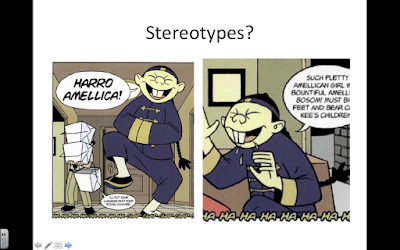Tackling Racism and the Idea of BELONGING
in Gene Yang's Graphic Novel
American Born Chinese
This year I read American Born Chinese with my sixth-graders. In ABC, author Gene Yang conveys a powerful message about racial stereotypes, identity, and the harm of personal transformation for the sake of conformation.
In his 2007 Printz Award winning graphic novel, Yang tells three stories: one about the Monkey King, another tells the story of a Chinese-American boy named Jin, and the third portrays an “All-American” teen named Danny. The stories start having very different plots, but read carefully and you will start to see connections between the narratives until the walls between stories evaporate completely.
Jin Wang is an American kid whose parents are both from China. Originally, Jin grew up in a San Francisco Chinatown and was surrounded by people just like him. When he was young, he went into an apothecary shop and heard an ominous portent from the shop owner. “ It’s easy to become whatever you want… as long as you’re willing to forfeit your soul.”
The theme of transformation is explored in all three stories. Jin Wang becomes frustrated by the problems his race has on his fitting in when he moves to a school where he is one of the only Asian kids. Teachers constantly pronounce his name incorrectly, kids use racial slurs, and stereotypes abound.
The Monkey King vows revenge on all living creatures after he is excluded from a party of the gods because he is not wearing shoes. He leaves his mountain kingdom and the other monkeys, changes his entire personality, masters the art of growing large and shrinking small, becomes immortal, and strives to get out of Tze-Yo-Tzuh’s (the god of all things) reach.
Danny is a white teenager; he’s blond, an athlete, a popular kid. His life is basically perfect, except that once a year, his cousin Chin Kee comes to visit. Chin Kee is the physical embodiment of all Asian stereotypes. His skin is yellow. He has buckteeth. He eats cats. His hair is braided. He wears traditional Chinese clothing. He pronounces Ls as Rs. His suitcases are actually Chinese take-out boxes.
Being confronted with a physical embodiment of all Asian stereotypes, seeing how ridiculous and hurtful they are do not make the readers laugh. We cringe.
Being confronted with a physical embodiment of all Asian stereotypes, seeing how ridiculous and hurtful they are do not make the readers laugh. We cringe.
We wonder why in the world Yang would include all of these stereotypes in his book until Danny confronts Chin Kee, knocking his head off… and we realize that Chin Kee is the Monkey King. The Monkey King asks Danny to take a hard look at himself in the mirror and the readers discover that Danny is actually… Jin.
The old lady’s warning about transformers starts to make much more sense. Jin has transformed into Danny to try to escape from the racial stereotypes that surround him. The monkey king left his fellow monkeys, started wearing shoes, and made himself tall like a human. All characters have changed themselves to become something new. But in doing so, they have ignored an important part of their identity and have therefore forfeited their souls.
The idea of transforming your personal identity to fit in is a struggle that middle schoolers deal with every day. ABC allowed my students to discuss tough issues like racial stereotypes and how we change ourselves to fit in. According to Davis, Brown, Liedel-Rice, and Soeder, "when teacher candidates read children’s literature about racism, they broaden their understanding of these important racial issues" (2005, p.177). Teaching multicultural literature is important. Students and teachers are in the classroom to learn and part of that learning is understanding that everyone has a slightly different perspective than you, has different life experiences, different lenses through which they view the world. It's important to try on a few pairs of classes and to see the world how others see it so we can understand and work with others and to develop empathy for other human beings.
Classroom Application
I read ABC with my class during our Belonging Unit. Before starting the book, the students wrote their own essential questions.
Then we discussed the book with a Socratic Seminar and students responded in a personal way on their blogs. Below is a student's response to the book.
“In this book, I learned that there really is real racism and stereotypes against different races. Also, I learned that people are sensitive about their reputation. After we read the book, our class had a socratic seminar. I learned that people can think differently about very huge issues such as racism. Also, I learned that many of my peers have faced the need to belong, stereotypes, and racism before.
The one thing that I pull out of the book is to never try to be someone who you're not. Monkeys can be monkeys, and children do not have to be alike to get along. They do not need to have the same skin color, or the way they talk does not have to be the same. Also, people do not have to be the same academic level to get along. People are actually more similar than they are different.”





No comments:
Post a Comment